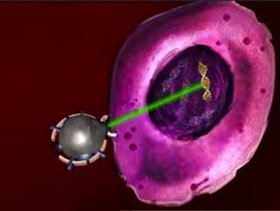Tomorrow's nanobots today


There's probably no more classic -- make that clichéd -- image associated with nanotechnology than that of the tiny robot swimming through the human body, dwarfed by nearby cells, performing some live-saving medical tasks. The nanobot's appearance contrasts sharply with that of the living structures on all sides: it is typically drawn to look like some miniaturized version of the remote-controlled submersibles used to explore the seafloor, right down to having prominent robotic claws (for wrestling recalcitrant flagella, I suppose).
But this image paints a misleading picture of what real nanotechnology is and how future medical treatments based on it may work. Mihail Roco, the chair of the U.S. National Science and Technology Council's subcommittee on nanotechnology, has often made the point that it's a mistake to think about nanotechnology purely in terms of size. Rather, we should think of it as the application of quantum mechanics (and physical phenomena dominant at the nanoscale) to the control of matter.
Nanotechnology then largely becomes an exercise in developing programmable matter -- that is, materials and objects with properties that will perform exactly as we want, when and where we want. The programming could involve the transmission of an actual command, but in most cases it would involve designing a material to react certain ways in response to predictable conditions.
At least two studies that have appeared in the past month offer amazing examples of how this will be true for medical nanotechnology. Both carry as a co-author Robert S. Langer of the Massachusetts Institute of Technology, who at this point is something of a living legend because of the number and range of cutting-edge materials for advanced medical applications that have come out of his laboratory.
Smart specks
Picture a cancer-fighting nanobot that, once inside the body, could navigate its way specifically to a tumor to deliver a chemotherapeutic drug locally, all the while evading the body's immune defenses. And just to lend it even more nano-goodness, imagine that this device could assemble itself from its constituent molecules. Surely it would deserve the Fantastic Voyage seal of approval as a medical mini-marvel.
In fact, such a device has now been created -- but it's less of a robot than a cunningly designed particle.
Such particles were originally devised at M.I.T. and Brigham and Women's Hospital in Boston, and are now being developed further under the trademarked name Accurins by BIND Biosciences of Cambridge, Mass., which was founded by Langer and his colleague Omid Farokhzad in 2007.
Biomedical researchers have been drawn to the idea of targeted nanoparticles for drug delivery for more than 30 years. In principle, receptor molecules on the surface of the particles can make them accumulate inside targeted tissues such as tumors, where they can spill out payloads of drugs that might be harmful to other tissues. Keeping the particles extremely small also ought to keep them out of the sites of macrophages and other immune cells that sweep up unwanted debris.
In clinical practice, though, targeted nanoparticles haven't worked out so well: achieving exactly the right balance of properties has been difficult. The nanoparticles often got swept out of the bloodstream and into the liver, or failed to release the drugs as planned.
BIND's science team may now have beaten that problem, however. Last month in Science Translational Medicine, Langer, Farokhzad and their associates reported exceptional success in a phase I, clinical-safety study of the experimental antitumor therapeutic called BIND-014.
At the core of the BIND-014 nanoparticle is a polymer that can slowly release the chemotherapy drug docetaxel. On the surface of the particles are small molecules, some of which help to keep the particles under the body's immunological radar. But the more important molecules on the surface are ones that will bind with a particular protein (called prostate-specific membrane antigen) found on prostate tumors and on the newly forming blood vessels that feed the growth of other types of solid tumors.
According to the published results, BIND-014 performed exceptionally well. In animal tests, the nanoparticle survived in the bloodstream much longer than unprotected docetaxel did. The concentration of the drug in the tissues that received the nanoparticle was consequently as much as 1,000 times higher. The actual cancer-killing effect of the nanoparticles needs to be tested further, but in this clinical safety trial, at least two of the human subjects saw a marked shrinkage in their tumors.
Beyond whatever direct potential BIND-014 shows for delivery of chemotherapy, the importance of this study may be in what it says about how to develop such targeted nanoparticles. The researchers hit on BIND-014 by a sophisticated form of mass trial-and-error testing called combinatorial chemistry: they checked out more than a 100 different variations of safe drug-release polymers to find ones that could self-assemble into nanoparticles with a promising set of attributes. Such a process is useful because it might offer a formula for creating nanoparticles with other biomedical applications.
Nanofactories
If you think BIND-014 seems a little too passive to qualify as a nanobot, you might be more excited by the stunning nanoparticles created by Avi Schroeder, Michael S. Goldberg, and Christian Kastrup at M.I.T. On command, the particles do something that only living cells normally do: they make proteins. (Charlie Osborne described this work for SmartPlanet.com previously.)
The protein molecules in many drugs often fare poorly in the bloodstream because the body collects or degrades them before they have much opportunity to do patients good. Many scientists (like those at BIND) have worked on ways to improve the delivery of proteins to where they are needed, but Schroeder and his colleagues had an inspiration to try something different: why not make the proteins where they are needed in the body?
In the laboratory, they extracted the contents from bacteria and enclosed them in lipid vesicles (loosely similar to the membranes around cells). The extract contained all the basic ingredients that cells normally use to make proteins, including the organelles called ribosomes.
The researchers also made sure that these nanoparticles contained small strands of DNA that encoded glowing proteins found in jellyfish and fireflies. The DNA, however, was locked up inside a molecular cage that would open only after exposure to ultraviolet light.
As the M.I.T. team described in Nano Letters in April, the nanoparticle factories behaved exactly as planned. They injected the nanoparticles into mice and found that they could make the tissues at the injection site glow under ultraviolet light, proving that the particles had switched on and manufactured the glowing proteins as desired.
What's life got to do with it?
I can almost hear some of the objections that might be out there. "But… but those particles barely seem like technology at all! They're practically biological!" Yes. That's the point.
Living things have been manipulating matter at the molecular scale for billions of years. It's debatable how soon human ingenuity will truly improve on the methods that biology worked out through evolution in all that time. But in any case, as our technology gets smaller and smaller, we should be prepared to let go of our old conceptions of what technology is or can be.
In those classic images of nanobots cruising through the bloodstream, our attention is misplaced. We look at the miniaturized robot, but the real marvels of nanotechnology in the pictures -- and the role models for the future -- are the cells on all sides.
This post was originally published on Smartplanet.com